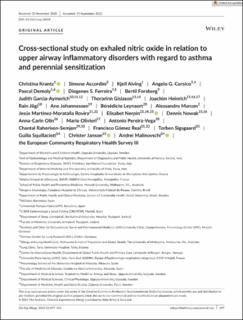| dc.contributor.author | Krantz, Christina | |
| dc.contributor.author | Accordini, Simone | |
| dc.contributor.author | Alving, Kjell | |
| dc.contributor.author | Corsico, Angelo G. | |
| dc.contributor.author | Demoly, Pascal | |
| dc.contributor.author | Ferreira, Diogenes S. | |
| dc.contributor.author | Forsberg, Bertil | |
| dc.contributor.author | Garcia-Aymerich, Judith | |
| dc.contributor.author | Gislason, Thorarinn | |
| dc.contributor.author | Heinrich, Joachim | |
| dc.contributor.author | Jõgi, Rain | |
| dc.contributor.author | Johannessen, Ane | |
| dc.contributor.author | Leynaert, Bénédicte | |
| dc.contributor.author | Marcon, Alessandro | |
| dc.contributor.author | Martínez-Moratalla Rovira, Jesús | |
| dc.contributor.author | Nerpin, Elisabet | |
| dc.contributor.author | Nowak, Dennis | |
| dc.contributor.author | Olin, Anna-Carin | |
| dc.contributor.author | Olivieri, Mario | |
| dc.contributor.author | Pereira-Vega, Antonio | |
| dc.contributor.author | Raherison-Semjen, Chantal | |
| dc.contributor.author | Real, Francisco Gomez | |
| dc.contributor.author | Sigsgaard, Torben | |
| dc.contributor.author | Squillacioti, Giulia | |
| dc.contributor.author | Janson, Christer | |
| dc.contributor.author | Malinovschi, Andrei | |
| dc.date.accessioned | 2022-04-01T11:56:13Z | |
| dc.date.available | 2022-04-01T11:56:13Z | |
| dc.date.created | 2022-02-04T07:53:01Z | |
| dc.date.issued | 2022 | |
| dc.identifier.issn | 0954-7894 | |
| dc.identifier.uri | https://hdl.handle.net/11250/2989284 | |
| dc.description.abstract | Background: Fractional exhaled nitric oxide (FeNO) is a well-known marker of type-2 inflammation. FeNO is elevated in asthma and allergic rhinitis, with IgE sensitization as a major determinant.
Objective: We aimed to see whether there was an independent association between upper airway inflammatory disorders (UAID) and FeNO, after adjustment for asthma and sensitization, in a multi-centre population-based study.
Methods: A total of 741 subjects with current asthma and 4155 non-asthmatic subjects participating in the second follow-up of the European Community Respiratory Health Survey (ECRHS III) underwent FeNO measurements. Sensitization status was based on measurement of IgE against airborne allergens; information on asthma, UAID and medication was collected through interview-led questionnaires. Independent associations between UAID and FeNO were assessed in adjusted multivariate regression models and test for interaction with perennial sensitization and asthma on the relation between UAID and FeNO were made.
Results: UAID were associated with higher FeNO after adjusting for perennial sensitization, asthma and other confounders: with 4.4 (0.9–7.9) % higher FeNO in relation to current rhinitis and 4.8 (0.7–9.2) % higher FeNO in relation to rhinoconjunctivitis. A significant interaction with perennial sensitization was found in the relationship between current rhinitis and FeNO (p = .03) and between rhinoconjunctivitis and FeNO (p = .03). After stratification by asthma and perennial sensitization, the association between current rhinitis and FeNO remained in non-asthmatic subjects with perennial sensitization, with 12.1 (0.2–25.5) % higher FeNO in subjects with current rhinitis than in those without.
Conclusions & Clinical Relevance: Current rhinitis and rhinoconjunctivitis was associated with higher FeNO, with an interaction with perennial sensitization. This further highlights the concept of united airway disease, with correlations between symptoms and inflammation in the upper and lower airways and that sensitization needs to be accounted for in the relation between FeNO and rhinitis. | en_US |
| dc.language.iso | eng | en_US |
| dc.publisher | Wiley | en_US |
| dc.rights | Attribution-NonCommercial-NoDerivatives 4.0 Internasjonal | * |
| dc.rights.uri | http://creativecommons.org/licenses/by-nc-nd/4.0/deed.no | * |
| dc.title | Cross-sectional study on exhaled nitric oxide in relation to upper airway inflammatory disorders with regard to asthma and perennial sensitization | en_US |
| dc.type | Journal article | en_US |
| dc.type | Peer reviewed | en_US |
| dc.description.version | publishedVersion | en_US |
| dc.rights.holder | Copyright 2021 the authors | en_US |
| cristin.ispublished | true | |
| cristin.fulltext | original | |
| cristin.qualitycode | 1 | |
| dc.identifier.doi | 10.1111/cea.14019 | |
| dc.identifier.cristin | 1997630 | |
| dc.source.journal | Clinical and Experimental Allergy | en_US |
| dc.source.pagenumber | 297-311 | en_US |
| dc.identifier.citation | Clinical and Experimental Allergy. 2022, 52 (2), 297-311 . | en_US |
| dc.source.volume | 52 | en_US |
| dc.source.issue | 2 | en_US |

